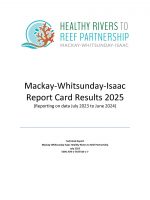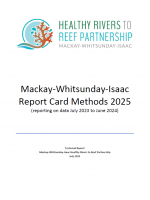2025 Report Card
The Report Card assesses the condition of waterways in the Mackay-Whitsunday-Isaac region and is released in July each year. We integrate a range of data from different monitoring programs to provide grades for freshwater, estuary, and marine environments, as well as human dimensions indicators including cultural heritage value, litter pressures, and urban water management.
By understanding how climate, population, development and land use affect our waterways at a regional level, we can inform management responses and actions tailored to our local area. We strive to provide a complete picture of regional waterway health.
For more information on the Report Card, check out our extensive FAQs.
Our latest Report Card was released in July 2025, and reports on waterway condition between July 2023 and June 2024. You can read the Report Card above, or download a pdf version.
If you would like physical copies of the Report Card for your business, school or organisation, please enquire at info@healthyriverstoreef.org.au.
Interactive Results Dashboard
Explore 10 years of data in the Interactive Results Dashboard. Here you will find detailed information on freshwater, estuary and marine grades and filter the information according to what interests you the most.
Key Findings
The 2025 Report Card has revealed a range of waterway health scores from ‘A’ to ‘C’ across the region’s 18 key graded areas, reflecting results for five freshwater basins, eight estuary areas and five marine zones.
Freshwater
- Water quality, fish community index and flow grades were updated for this reporting period. Fish barriers, impoundment length, riparian extent and wetlands extent indicators were based on repeat data.
- There was only 1 grade change compared to the previous reporting period, with Proserpine Basin declining from B to C overall.
- The Don and Proserpine Basins recorded increased numbers of pest fish, such as Mosquito Fish, Guppies and Tilapia. This highlights the importance of native fish habitat and responsible disposal of aquarium pets
- There is now statistical evidence to suggest agricultural extension and farm practice improvements are having a positive impact, with a significant decrease of PSII herbicide concentrations (such as diuron and atrazine) and associated pesticide risk recorded at the Sandy Creek Homebush site (in the Plane Basin) since 2016. In parallel, there has been a statistically significant increase in the concentrations of other types of herbicides and insecticides that may be less toxic than PSII herbicides, but still pose a risk to aquatic ecosystems.
Estuary
- Water quality was updated this reporting period. Habitat and hydrology grades were based on repeat data.
- Vines Creek Estuary was the only estuary to record a grade decline from B to C due to declines in all water quality indicator scores.
- Since Report Card inception there has been a general increasing trend in Chlorophyll-a concentrations in most estuaries. This year, 7 out of 8 estuaries showed a decline in this key water quality indicator, which reflects changes in algal growth.
Marine
- All Inshore Marine Zone indicators (water quality, seagrass and coral) were updated in this reporting cycle. Offshore coral was also updated. Offshore water quality is not currently reported.
- Project Blueprint data has been included in the Report Card for the first time, increasing the representative sample for water quality in the Whitsunday Inshore Zone. This collaborative project involves the collection of water samples at two key tourism sites in the Whitsundays – Cairn Beach and Tongue Bay.
- The Southern Inshore Zone was the highest scoring zone for seagrass with composition, area and biomass all receiving A’s. It was the only inshore zone to score very good for seagrass this year. This data is collected as part of the Partnership-led Southern Inshore Monitoring Program.
See the 2025 Results Report for detailed results for each indicator and site, and the 2025 Methods Report for detailed sampling and scoring methodology.





